When you take a 23andMe DNA test, you have the option to view your list of DNA relatives who have also tested with 23andMe.
This list shows you other 23andMe customers who share a minimum threshold of DNA with you.
This article is a comprehensive guide on how to read, interpret, and use your 23andMe DNA relatives to research your family.
How Many DNA Relatives Do You See On 23andMe?
If you are on the standard subscription level with 23andMe, you get a maximum of your top 1,500 DNA relatives.
American users can pay a premium to increase the maximum to 5,000 DNA relatives.
As new customers test with 23andMe, your list of relatives will keep changing.
If a new customer shares more DNA with you than the lowest match in your list, the new customer will be added. To keep to the cap, the lowest relative drops out of your list.
How Do 23andMe Determine Relatives?
Every customer who takes a 23andMe DNA test has the option of being included in their DNA matching database.
When your DNA kit is processed, your results are checked against every other DNA kit in this database.
23andMe compares two DNA kits by counting how many tiny pieces of DNA are identical.
How 23andMe compares two DNA kits
The DNA matching process looks at specific positions (or DNA markers) on each chromosome. 23andMe uses over 600,000 markers when comparing DNA results.
Let’s say that the matching process is working across thousands of markers on Chromosome 12. The two kits are my own and a distant cousin.
When the process hits position #71720971, it finds that a tiny piece of our DNA is identical between our results.
If the next adjacent tiny piece is not identical, then this length of matching DNA is too small to be significant. The shared DNA is due to chance, not through a common ancestor.
Is there enough matching DNA to be related?
23andMe requires five adjacent pieces of DNA to be identical. Otherwise, the process jumps to the next marker to start looking for the next identical piece.
In the example below, there is a stretch of twenty adjacent pieces of DNA that are identical between the kits.
We measure these pieces in “centimorgans” or cM. So, I share 20 cM with this DNA match.
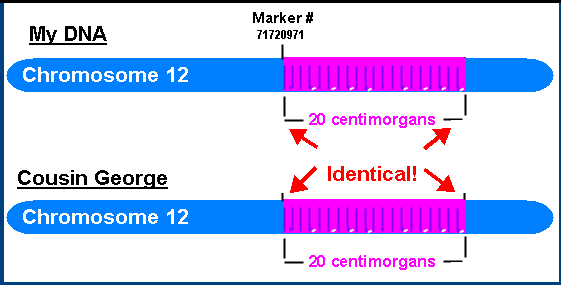
If this was the only identical section across all our chromosome pairs, then 23andMe also represents this as 0.29% shared DNA.
How accurate are 23andMe DNA relatives?
23andMe will be very accurate at the level of close family.
They will assign a label of father, mother, brother, or sister if these family members have also tested with the company.
Like all the DNA testing companies, the measurements become less accurate at the lower levels of shared DNA.
You will share small sections of DNA by chance with unrelated individuals. So, if you’re working at the bottom of your list of relatives, there is a higher likelihood that the shared DNA is due to chance.
How To Launch The 23andMe DNA Relatives List
There are several ways to open your DNA Relatives list. The easiest way is to use the menu at the top of every page.
Expand the “Ancestry” drop-down menu and choose “DNA Relatives”.
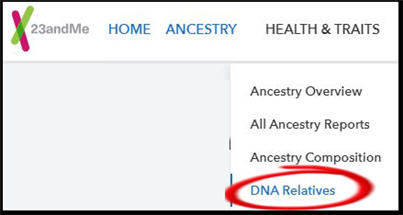
Be cautious about predicted relationships
23andMe shows a predicted relationship on the DNA Relatives display. This may be very specific e.g. “Father”, “Daughter” or “Brother”.
Here is one of my relatives with a “Fourth Cousin” label.

This relative is actually my 3rd cousin. We share great-great-grandparents. So, why has 23andMe labeled this wrong?
The reason is that 23andMe measures the amount of DNA we share. But the nature of genetic inheritance means that many relationships can share a similar amount.
My 3rd, 4th, and 5th cousin could all share 0.29% DNA with me. 23andMe picks one as a prediction. But keep in mind that the prediction may not be right.
This gets more obvious if you see your aunt labeled as your grandmother or a first cousin. Do not draw conclusions based on this predicted relationship label.
Instead, dive into the details by clicking on the DNA relative to open the dedicated page for this person.
DNA Relative Page
When you click on a relative in the list, you launch the dedicated page.
Some of the information here is more useful than in other sections. I’ll work down from the top.
Most recently active
The “Active” section is very useful when you’re choosing which of your relatives to contact.
Someone who hasn’t logged in in six months may only have been interested in their health reports or their ethnicity breakdown.
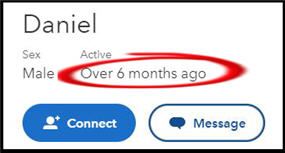
I use the Active information as a flag to indicate how likely relatives are to respond to my messages. I have a full section later on increasing your chances of getting replies.
View DNA details
I don’t know why 23andMe buries the most useful information behind multiple clicks.
The detailed display repeats the predicted relationship at the top of the page. I’ve already mentioned that you shouldn’t take this as gospel.
In fact, the little pencil icon lets you change the relationship to whatever you want.
Beneath the prediction, you get a visual display of the possible relationship. Scroll on down to the link that will show you the important DNA details.
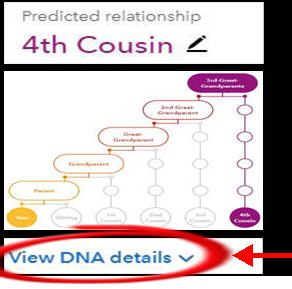
The “View DNA details” link shows you a detailed breakdown at the chromosome level.
The display is in the format of a one-to-one chromosome browser. I’ll explain that in the next sections.
Where Are The Centimorgans?
I wish 23andMe would show the number of shared centimorgans on the Relatives list, alongside the percentage. But that’s because I’m used to thinking in cMs.
There’s an approximate calculation to transform percentages into centimorgans (multiple by 68).
But 23andMe also bury the cM down here under “View DNA details”. It’s at the top of the expanded display, under the percentage.
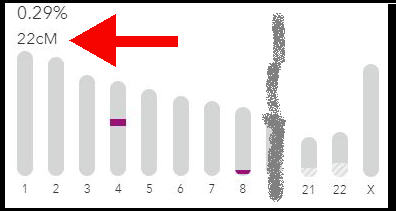
Beneath the number of centimorgans, you’ll see the one-to-one chromosome browser.
One-To-One Chromosome Browser On The Relative Page
If you’re starting out with 23andMe, don’t get too bamboozled by the chromosome browser.
You can go a long way with researching your relatives by just knowing the percentage of shared DNA or the number of centimorgans.
But when you’re ready to try some advanced techniques, then come back to this section for a 101.
Earlier, I showed a diagram that represented the shared DNA on the 12th chromosome of myself and my cousin. That diagram laid the chromosomes out horizontally.
23andMe shows us a vertical display that represents 22 chromosome pairs and the X chromosome.
The display below tells me that I share identical DNA segments with Daniel on two different chromosome pairs: #4 and #8. (I’ve snipped out the 9th-20th chromosomes for space).
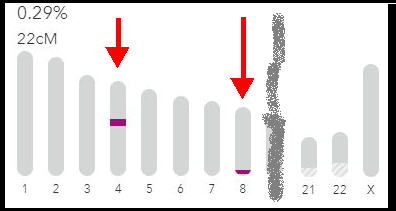
Triangulation
Knowing the specific chromosome isn’t very useful when you’re just comparing two relatives.
But, the chromosome browser comes into play when you’re working with a group of relatives whom you suspect are descended on the same family branch.
What you’re looking for is evidence that suggests that the same piece of DNA on the same chromosome was passed down from a single ancestor through several generations. This is known as triangulating your relatives.
Suppose you see that four of your relatives share DNA with you on different chromosomes? Then the likelihood is that members of this group don’t all share the same common ancestor.
I won’t go into this in more depth here. It deserves an article to itself. I do recommend that you consider transferring your DNA to GEDmatch to use their triangulation tools too.
Family Tree Information On The Relative Page
Scroll down further on the DNA Relative page, and you’ll come to the Family Background section.
23andMe lets us enter these background details on our Account Profile. Some of your relatives won’t provide the information.
Look out for the people who provide details, because they are probably more open to contact.
The display is a side-by-side comparison.
Grandparents birthplace
Below, I’m showing an excerpt of the birthplace comparison between my kit and a relative. If I contact this person, I’ll mention that our likely connection is through this maternal grandfather.

Family surnames
Hopefully, you’ll see some surnames listed below the birthplace details.
I’ve added the surnames of my known 2nd great-grandparents.
I notice that many people stop at the grandparent level i.e. they add four surnames. There’s no reason to limit yourself to this generation. Go back as far as you can!
Here’s an example display from my list. Unfortunately, Smith is the common surname here – that doesn’t make things easy!

Relatives In Common Section On The Relative Page
Scroll down further on the DNA Relative page and you’ll get to the “Relatives In Common” section. Click on the big blue button to bring up the new list.
Your Relatives in Common are the people who share a significant amount of DNA with both you and the target relative.
One way to use this feature is to start with a known DNA relative i.e. you have identified where this relative is in your family tree. This gives you a head start when looking at the relatives in common.
We have a separate article on this topic, so I won’t go into detail here. You can check out our walkthrough on how to use Relatives In Common on 23andMe.
Ancestry Composition Section On The Relative Page
This is the section to which I pay the least attention. However, I have a very simple composition. I might find it more useful if I had a more diverse breakdown.
The other question is whether the 23andMe estimates are accurate enough to guide your research. Check out our article that reviews the accuracy of your 23andMe ancestry composition.
Sorting Your DNA Relatives
When you open the Match List, your matches are displayed by default in descending order of a combination of percentage and segments.
If you’re wondering why a relative of 0.64% is higher up the list than one with 0.78%, look at the number of segments. The slightly lower percentage will probably be across more segments.
You can change the sort order at the top right of the page.
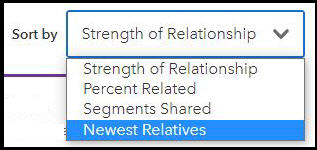
I often like to switch to “Newest Relatives”.
When you’re in your first weeks or months of using 23andMe, stick to the default sort order and work through your top DNA relatives. These are usually the easiest ones for identifying your connection.
It’s normal to taper off to visiting the website at weekends to continue your research. Toggling the sort order to Newest Relatives lets you quickly scan for interesting recent arrivals.
Keyword Search On The DNA Relatives List
The left side of the DNA Relatives list page has search and filter options.
The filters allow a generalized approach to working with your matches. You apply broad restrictions, and slowly narrow down the field.
In contrast, the search box gives you a targeted investigation.
We covered the Family Background section which shows birthplaces and surnames entered by your DNA relatives. The search box will look for hits from this information.
Name search
I advise that you don’t take a scatter-gun approach of throwing in any family surname that comes to mind. Instead, prepare a target hit list for your research.
You can start small with the surname hit list, and keep adding to it.
Now and then, your research will extend a branch in your tree and new names will come in. Go add the names to your hit list!
Remember that new relatives are regularly trickling in. Periodically, perhaps once a month, you can start at the top of the list and work through your surnames again.
Location search
I find that I get the most hits with broad locations. People tend not to enter detailed addresses in 23andMe.
So for Ireland, I get hits at the County level but not for smaller towns.
Filtering Your DNA Relatives
23andMe has gradually increased the number of filters available on the List page.
You should experiment with them all, but I’ll focus on my two favorites.
Ancestor birthplaces filter
This is a really neat display that I think is unique to 23andMe. I haven’t seen similar on Ancestry.com or MyHeritage.
The first thing to notice is the numbers beside the listed countries. This is the number of matches who have included the country in their family background.
23andMe limits the list of countries to the top 20. But you’ll probably see a fascinating spread of diverse countries across your DNA relatives.
Be sure to click on individual countries, because the display gets even more useful!
In the display below, I’ve clicked on my Ireland breakdown.
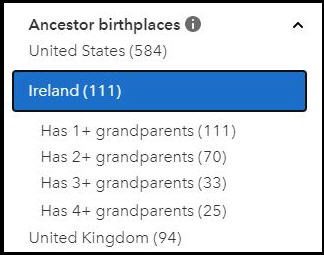
Here you’ll get a further filter by how many grandparents each relative has placed in this country.
Family names filter
Don’t be surprised to see Smith and Jones at the top of the family names filter. The top names will simply follow the prevalence of surnames in Western Europe and North America.
My best advice is to hang out in the second half of the list and look for names that don’t strike you as very common.
DNA Relatives Map
The Relatives Map is an alternative way at looking at your DNA relatives by grouping them by location. The location comes from the user account profile.
It’s easy to forget that the map display exists. You can toggle to it by using the tabs at the top of the List page.

As you zoom into the picture, the map becomes more and more granular.
Personally, I don’t use this display very much. But you if are more visually inclined, you may love it.
How To Contact 23andMe Relatives
You contact your DNA relatives by sending messages via the 23andMe messaging system.
Unfortunately, you are unlikely to get responses to every one of your messages. Depending on how you go about this, you may get very few replies.
So, how about some guidelines for targeting your contacts and sending messages that are more likely to get replies?
I’ll get to that in a separate article! Check out our full guide on sending messages to 23andMe relatives that get replies.
23andMe Family Tree
This feature is also available from the tabs at the top of the Relatives List page.
The 23andMe version of a family tree is quite different from a normal genealogy family tree.
Check out our full guide to using the 23andMe family tree feature.
Working With DNA Relatives on Other Sites
The biggest drawback to 23andMe, in my opinion, is the lack of a standard family tree feature.
Other DNA sites like Ancestry.com, MyHeritage, and GEDmatch allow users to create or upload standards family trees.
In contrast, 23andMe makes it more difficult to research your connection with DNA relatives without direct contact.
However, you can transfer your DNA to some of these other sites for free to get access to more DNA relatives. You may also recognize matches from 23andMe if they keep the same username across sites.
We have a round-up article that covers uploading your DNA to reputable sites for free.